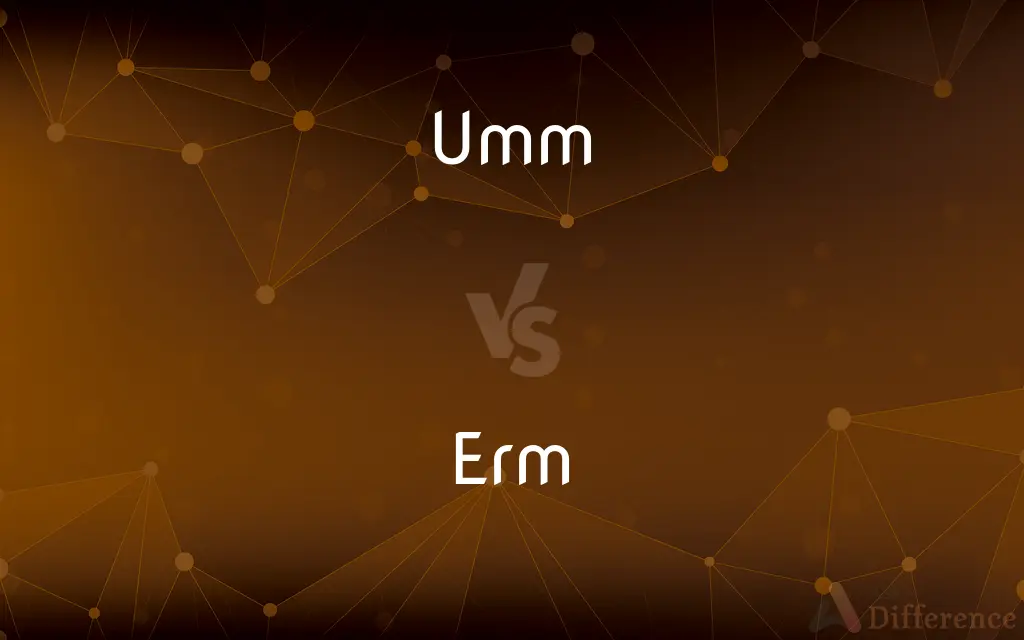Umm vs. Erm — What's the Difference?
By Fiza Rafique & Urooj Arif — Updated on March 28, 2024
Umm and erm are both verbal fillers used in speech to indicate hesitation or a pause to think, but they vary by dialect and personal preference.

Difference Between Umm and Erm
Table of Contents
ADVERTISEMENT
Key Differences
Umm is a common verbal filler in American English, used by speakers to signal hesitation, a pause for thought, or uncertainty during conversation. It's a way for the speaker to indicate they are processing their thoughts or searching for the next words. Whereas erm is more commonly used in British English and serves the same purpose as "umm." It signals a pause, hesitation, or the need for a moment to gather thoughts before continuing.
The choice between umm and erm often depends on the speaker's linguistic background or the influence of the dialect they are most exposed to. While umm is prevalent in American English, reflecting the linguistic norms and speech patterns of the region, erm reflects the nuances and preferences of British English speakers.
Both umm and erm function as linguistic devices that allow the speaker a momentary pause without breaking the flow of conversation entirely. They can indicate the speaker is considering their response carefully, is unsure, or simply needs a moment to recall information. However, the frequency and context in which they are used can vary between individuals, sometimes depending on the situation or the speaker's comfort level.
Despite their similarities, umm and erm can subtly influence the perception of the speaker's confidence or decisiveness. Overuse of either can suggest hesitancy or a lack of preparation, whereas moderate use might simply reflect natural speech patterns. The perception of these fillers can also be influenced by cultural factors and listener expectations.
In some contexts, umm and erm are also used for dramatic effect, to build suspense, or to draw attention to the forthcoming statement. On the other hand, in formal settings or public speaking, the use of these fillers is often minimized to maintain a flow of speech that projects confidence and clarity.
ADVERTISEMENT
Comparison Chart
Dialect
Predominantly American English.
More common in British English.
Function
Indicates hesitation, pause for thought, or uncertainty.
Serves the same purpose, signaling a moment to gather thoughts.
Contextual Use
Reflects linguistic norms of American speakers.
Reflects the nuances of British English speakers.
Perception
Can suggest hesitancy if overused but is a natural speech pattern.
Similarly, overuse may imply a lack of confidence or preparation.
Formality
In formal settings, its use is minimized.
Also minimized in formal or public speaking contexts.
Compare with Definitions
Umm
A verbal filler used to indicate hesitation or pause in American English.
Umm, could you repeat the question?
Erm
Signals a brief interruption in thought or speech.
Erm, do you really think that’s a good idea?
Umm
Can indicate a polite hesitation before delivering an opinion or feedback.
Umm, I think there might be a better way to do this.
Erm
A verbal pause or filler in British English, indicating hesitation.
Erm, what was I saying?
Umm
Signals the speaker's need for a moment to think or recall information.
Umm, I believe the meeting is at 3 PM.
Erm
Used when the speaker is thinking or unsure about their next words.
Erm, it’s on the tip of my tongue.
Umm
Reflects uncertainty or the search for the correct word or phrase.
Umm, that’s not exactly what I meant.
Erm
Often precedes a cautious or reconsidered response.
Erm, perhaps we should discuss this further.
Umm
Often used to prevent silence while the speaker formulates a response.
Umm, let’s consider another option.
Erm
Reflects the speaker's attempt to recall or decide on something.
Erm, let me check my schedule.
Umm
Used to express doubt or uncertainty or to fill a pause when hesitating in speaking.
Erm
(UK) Used in hesitant speech, or to express uncertainty; um, umm.
She was going to, erm... the salon, I think.
Umm
Implying hesitation.
- How does a plane fly?
- Umm, I don't know.
Erm
(UK) Used to express embarrassment or subtle disagreement.
Erm, I don't think that was supposed to happen.
- Bob would never say something like that!
- Erm, he just did.
- Erm, he just did.
Umm
To make the umm sound to express confusion or hesitancy.
Common Curiosities
Are umm and erm considered unprofessional?
While common in casual speech, excessive use of umm and erm in formal settings can be perceived as a lack of confidence or preparation.
Is there a difference in meaning between umm and erm?
No significant difference in meaning exists; the variation mainly lies in regional usage and personal speech habits.
How can one reduce the use of umm and erm in speech?
Practicing speeches, pausing silently instead of using fillers, and becoming comfortable with brief moments of silence can help reduce their usage.
Why do people use umm and erm?
People use umm and erm as verbal fillers to signal hesitation, give themselves time to think, or fill pauses in conversation.
Do umm and erm have equivalents in other languages?
Yes, most languages have their own versions of verbal fillers that serve similar purposes in conversation.
Can using umm or erm affect communication?
Used sparingly, they can make speech seem more natural, but overuse might distract listeners or undermine the speaker's message.
Are umm and erm used differently in various English-speaking countries?
Yes, the preference for umm or erm can vary, with umm more common in American English and erm in British English.
Do umm and erm serve any positive purpose in conversation?
Yes, they can signal to the listener that the speaker is thinking or pausing for thought, maintaining the flow of conversation and indicating engagement.
Can the use of umm and erm vary within the same country?
Yes, individual speech patterns, education, and regional dialects can influence the use of these fillers even within the same country.
Is it possible to completely eliminate umm and erm from one's speech?
While it may be challenging to eliminate them entirely, awareness and practice can significantly reduce their frequency.
Share Your Discovery

Previous Comparison
Arc vs. Line
Next Comparison
Peseta vs. PesoAuthor Spotlight
Written by
Fiza RafiqueFiza Rafique is a skilled content writer at AskDifference.com, where she meticulously refines and enhances written pieces. Drawing from her vast editorial expertise, Fiza ensures clarity, accuracy, and precision in every article. Passionate about language, she continually seeks to elevate the quality of content for readers worldwide.
Co-written by
Urooj ArifUrooj is a skilled content writer at Ask Difference, known for her exceptional ability to simplify complex topics into engaging and informative content. With a passion for research and a flair for clear, concise writing, she consistently delivers articles that resonate with our diverse audience.
















































